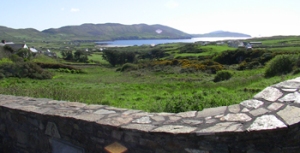 |
| Veronica Steele |
In 2010, I took a break from work in the digital world to explore the ancient, multi-sensory realm of artisan cheesemaking.
While employed as a cheesemonger at
Cowgirl Creamery in Northern California's Point Reyes Station, I read an article in
Culture magazine about County Cork and Irish farmhouse cheesemakers on the Beara Peninsula who make a variety of “
washed-rind” cheeses with a distinctive red hued rind. It struck me that the color much resembled that of smelted red copper which is the economic mainstay of Butte, Montana, where I grew up.
The Irish immigrants who worked in the copper mines of Butte more than a hundred years ago mostly came from County Cork. Thinking it would be wonderful to introduce Butte to this savory variation of copper, I wrote to
Veronica Steele of
Milleens Cheese in Eyeries, Ireland, and asked about her willingness to teach cheesemaking classes during
An Ri Ra 2013, Butte’s annual Irish Festival. Her response opened a whole new understanding for me about the Butte - County Cork connection.
Hi, Cynthia, It would be amazing to go to Butte, Montana to conduct a class. This area of Ireland has huge connections to Butte. It's spoken of as though it were the next village. If you ever get the resources together, I'll be over in a shot! Best wishes, Veronica
Allihies Copper Ends - Butte Copper Begins
 |
| Allihies, Ireland |
Everyone with Irish ancestry in Butte grows up hearing about County Cork, but no common mention is made about the bulk of Irish miners coming from
Allihies, a small copper-mining village on the southwestern reaches of the Beara Peninsula.
 |
| Beara Ancestry Record |
Copper mining began in
Allihies as early as the Bronze Age. In the Industrial Era of the 1800's, it became a
full-scale commercial production. Then, in the 1870's, the veins began to play out just as the Copper Kings in Butte, half a world away, were getting started.
With enticement from copper barons like Marcus Daly, the exodus of miners from Allihies seemed to take place overnight. Veronica's comment about Butte being "spoken of as though it were the next village" was no exaggeration. This story captured my imagination. Six months later I was seated with Veronica at a table in her house, enjoying Milleens Cheese and learning about the very people I knew while growing up.
Midway through our visit, Veronica and her husband Norman introduced me to volumes of Beara family histories compiled by
Riobard O'Dwyer. Called "
My Ancestors (Annals of Beara)", the words "Butte, Montana" echoed through the pages like a supplication. That day, Veronica and I outlined a nascent plan, called the Copper Cais Project. Cais is the Gaelic word for cheese. Given that the most common association to Ireland in Butte is about alcohol, we intended to diversify that bond with the addition of fine food.
The Milk of Ireland Ripened in the Heart of Butte
From Allihies, I went straight to Butte and began laying the foundation for Veronica to conduct cheesemaking and cultural history classes there the next year. As a long-term economic incentive, we also proposed to experiment with using an old Butte copper mine as an aging cave for cheese made in Ireland. Abandoned mines have been used successfully as aging caves throughout the world so this was an achievable dream. In fact, our slogan -
The Milk of Ireland Ripened in the Heart of Butte - had the ring of a perfect marketing campaign.
I built a project website, made arrangements for Veronica's classes, and even scouted an old Butte mine shaft as a possible
affinage site. Back in Ireland, Veronica researched ways to bring her cheese through customs without fear of confiscation. All was proceeding on target until fate took control of our plan. Less than a year after I met Veronica, she developed
Multiple System Atrophy (MSA), a fatal neurological disease. Though we tried to move forward with modifications, it was soon obvious that our vision was no longer possible.
Veronica and I kept in touch over the internet as she survived a few more years. Despite extreme physical and psychological challenge, she remained an active member of her family and community. Cheesemakers from around the world paid ongoing tribute to her.
Of course, I felt deep disappointment at the loss of a new and magical friendship with Veronica whose depth and force of capability created an international legacy, all from a remote farmhouse on an ancient island; and of the opportunity to share her inspiration in the place where I grew up. But the insight to be gained from such turns lies in appreciating the voyage from a wider view.
Locations at the outer reaches of Ireland are served by infrequent public transportation. Most people simply rely on car rides with others. So Veronica and Norman arranged for me to stay overnight in their daughter's house in Allihies before returning to Cork City. (The Steele family, by the way, personifies the kind of relationship that will only be an aspiration for most of us.)
 |
| North Star beckons to Allihies |
In a small village with no artificial night light, Polaris shone bright above the black horizon of the North Atlantic. It called my attention to the West, and I saw what they once saw, those ancestors who braved their way from Allihies to Butte. The phrase "beacon of hope" will never have a more fitting rendition in my mind.
Now I'm taking this experience to life through animation. The working title is CopperMind. Let the stars be my guide.
















